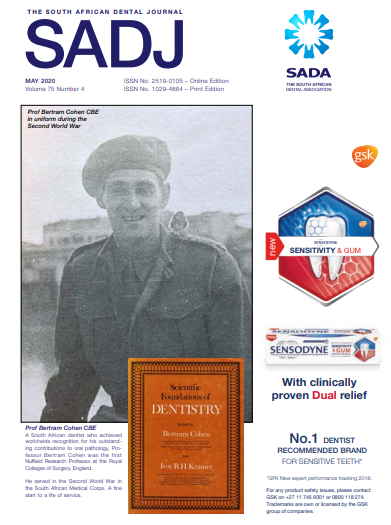The Microbiology of head and neck space infections at the Maxillofacial Clinic at Livingstone Hospital
DOI:
https://doi.org/10.17159/2519-0105/2020/v75no4a4Keywords:
head and neck space infections, Maxillo-Facial clinics, non-odontogenic, submandibular space, Gram positive facultative anaerobes, Bacteroides, Viridans streptococci, Staphy-lococcus aureusAbstract
INTRODUCTION: Head and neck space infections remain one of the most commonly encountered conditions at Maxillofacial clinics countrywide. Patients admitted with these infections tend to have prolonged hospital stays and often require intensive care support. This places financial and logistic constraints on our health care system. There are also growing concerns, worldwide, regarding antibiotic resistance AIMS AND OBJECTIVES: To determine the microbial spectrum of head and neck space infections in patients admitted to the Maxillo-Facial clinic at Livingstone Hospital in the Eastern Cape over a period of 5 years. METHODS: Demographic, clinical and laboratory data was retrieved from the medical records of 140 patients presenting with head and neck space infections RESULTS: Most patients were males aged 21-40 years. The most common cause of head and neck infections was non-odontogenic. The submandibular space was the most commonly implicated. Gram positive facultative anaerobes were most commonly identified. Bacteroides species and Staphylococcus aureus displayed sensitivity to clindamycin and amoxicillin with clavu-lanic acid. Viridans streptococci were sensitive to both penicillin and clindamycin CONCLUSION: Bacteroides species were the most commonly isolated bacteria, followed by Viridans streptococci and Staphy-lococcus aureus.
Downloads
References
Boscolo-Rizzo P, Da Mosto MC. Submandibular space infection: a potentially lethal infection. Inter J Infec Dis. 2009; 13: 327-33.
Mathew GC, Ranganathan LK, Ghandi S et al. Odontogenic maxillofacial space infections at a tertiary care centre in North India: a Ave year retrospective study. Int J Infec Dis. 2012; 16: e296-e302.
Bahl R, Sandhu S, Singh K, Sahai N, Gupta M. Odonto-genic infections: Microbiology and management. Contemp Clin Dent. 2014; 5: 307-11.
Fating NS, Saikrishna D, Vijay Kumar GS, Shetty SK, Rao MR. Detection of bacterial flora in orofacial space infections and their antibiotic sensitivity profile. J Maxillofac Oral Surg. 2014; 13: 525-32.
Molomo EM, Motloba DP, Bouckaert MM, Tlholoe MM. Bacteriology and management of orofacial infections in a Maxillofacial and Oral Surgery Clinic, South Africa. S Afr Dent J. 2016; 71: 474-7.
Rega AJ, Aziz SR, Ziccardi VB. Microbiology and antibiotic sensitivities of deep neck space infections. J Oral Maxillofac Surg. 2004; 62: 25-6.
Shah A, Ramola V, Nautiyal V. Aerobic microbiology and culture sensitivity of head and neck space infection of odontogenic origin. Nat J Maxillofac Surg. 2016; 7: 56-61.
Singh M, Kambalimath DH, Gupta KC. Management of odontogenic space infection with microbiology study. J Maxillofac Oral Surg. 2014; 13: 133-9.
Cabral M, Gowrishankar S, Amerally P. Investigation of the microbiology and antibiotic sensitivity of skin and soft tissue infections of the head and neck region. Br Oral Maxillofac Surg. 2016; 54: 124-5.
Walia IS, Borle RM, Mehendiratta D, Yadav AO. Microbiology and antibiotic sensitivity of head and neck space infections of odontogenic origin. J Maxillofac Oral Surg. 2013; 13: 16-21.
Ye L, Liu Y, Geng A-L, Fu H-Y. Microbiological examination to investigate the differences in microorganisms and anti biotic sensitivity of head and neck space infections. Biomed Res. 2017; 28: 290-4. [ Links ]
Ibeyemi ST, Okoje-Adesomoju VN, Dada-Adegbola HO, Arotiba JT. Pattern of orofacial bacterial infections in a tertiary hospital in southwest Nigeria. J West Afr Coll Surg. 2014; 4: 112-41.
Costa SF, Miceli MH, Anaissie EJ. Mucosa or skin as source of coagulase-negative Staphylococcal bacteraemia? Lancet Infec Dis. 2004; 4: 278-86.
Ho MP, Tsai KC, Yen SL, Lu CL, Chen CH. A rare cause of Ludwig's angina by Morganella morganii. J Infec. 2006; 53: e191-4.
Stock I, Gruger T, Weidemann, B. Natural antibiotic susceptibility of strains of the Enterobacter cloacae complex. Int J Antimicr Agents. 2001; 18: 537-45.
Fernadez-Canigia L, Legaria MC, Castello L et al. First national survey of antibiotic susceptibility of the Bacteroides fragilis group: Emerging resistance to carbapenems in Argentina. Antimicr Agents Chem. 2012; 56: 1309-14.
Downloads
Published
Issue
Section
License
Copyright (c) 2020 Nerisha Singh, Sizakele Ngwenya, Julitha Molepo

This work is licensed under a Creative Commons Attribution-NonCommercial 4.0 International License.






.png)